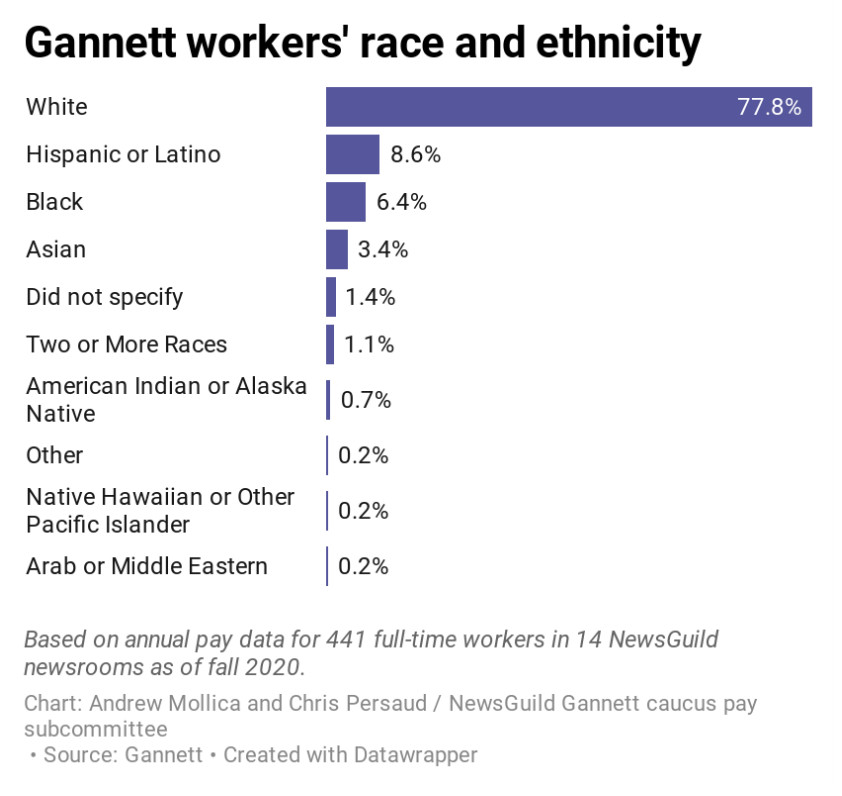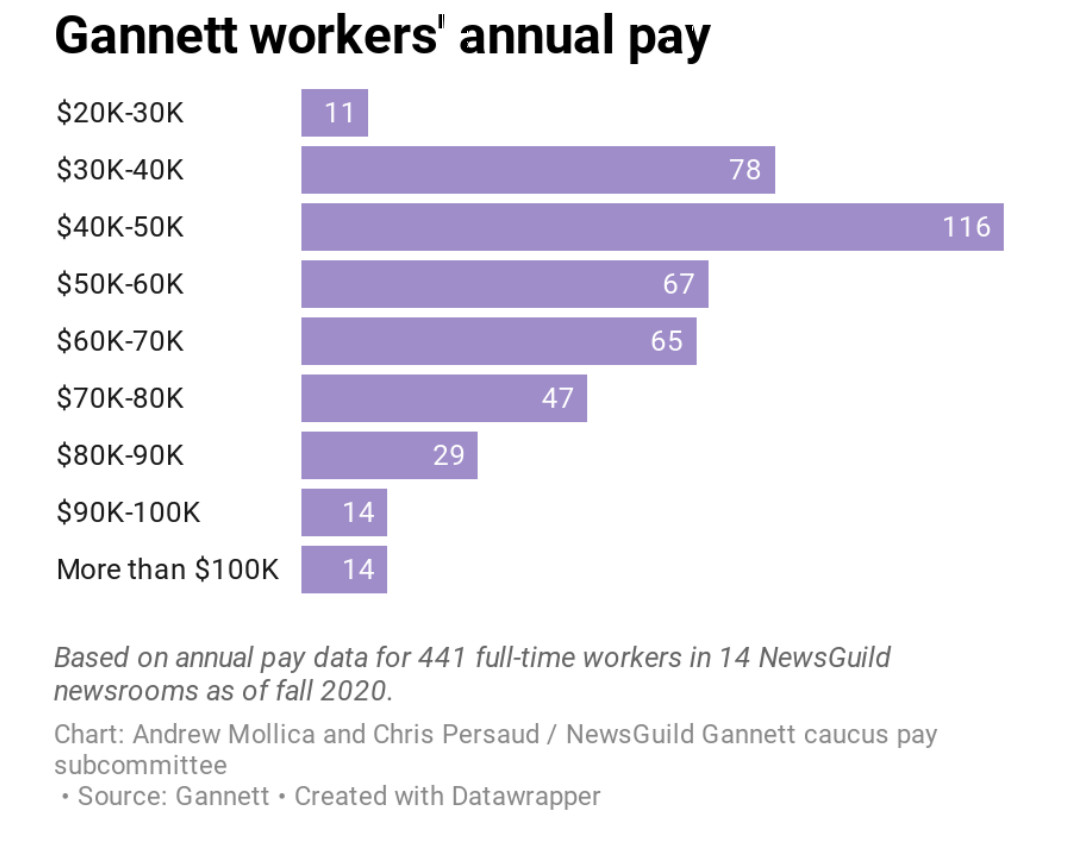Sign up for the daily CJR newsletter.
On Tuesday, the NewsGuild-Communications Workers of America published a pay equity study on Gannett-owned newsrooms that found significant pay inequity for women and journalists of color, as well as further evidence of an overwhelmingly white, male workforce “less racially diverse than the U.S. as a whole.”
The NewsGuild study comes after Gannett’s pledge in August 2020 to better foster a “culture of inclusion” for women, people of color, and other underrepresented groups in their newsrooms. After merging with GateHouse Media in November 2019, Gannett is now the largest newspaper chain in the country, with more than 250 local daily newspapers in its portfolio. Nearly one in six newspapers across the US is owned by the publisher.
In a first of its kind report for the chain, Gannett released comprehensive data on workforce demographics across race, ethnicity, and gender last August. Gannett has pledged to update this data bi-annually. However, data on salaries is, at least for now, exclusively limited to unionized newsroom members within the company. The release of this information is required under U.S. labor laws and is why Gannett journalists involved in the study were limited to their own newsrooms’ earnings data.
The NewsGuild examined 441 full-time and 25 part-time, non-managerial workers’ median pay from fall 2020 across gender and race demographics in 14 Gannett-owned newsrooms belonging to the union, including newspapers such as the Palm Beach Post, the Indianapolis Star, and the Florida Times-Union. All of the workers in the study were on the editorial side of the newsrooms. The report found that Gannett-owned newsrooms are whiter and generally “less racially diverse than the communities they serve,” with the exception of a single newsroom in the study.
 There were also notable pay gaps for women and journalists of color. Women across the board earned almost $10,000 less, or 83 percent of men’s median salaries each year. Women of color earned around $15,700 less, or 73 percent of white men’s median salaries. These findings are in step with general news industry trends. According to a 2018 study by the Pew Research Center, newsroom employees were “more likely to be white and male than US workers overall,” with non-Hispanic whites making up more than three quarters of newsroom employees and males making up almost 61 percent of the total workforce.
There were also notable pay gaps for women and journalists of color. Women across the board earned almost $10,000 less, or 83 percent of men’s median salaries each year. Women of color earned around $15,700 less, or 73 percent of white men’s median salaries. These findings are in step with general news industry trends. According to a 2018 study by the Pew Research Center, newsroom employees were “more likely to be white and male than US workers overall,” with non-Hispanic whites making up more than three quarters of newsroom employees and males making up almost 61 percent of the total workforce.
The NewsGuild report also claims that “unionizing improves pay equity” across both gender and race, with a gender pay gap around $6,800 smaller and a racial pay gap about $5,400 smaller in newsrooms with longstanding contracts compared to those negotiating first contracts.
 The largest gender and racial pay disparities of all the bargaining units were found at the Arizona Republic, which is also the most diverse newsroom included in the study. There, women earned only 67 percent of men’s median pay and journalists of color earned a mere 63 percent of white workers’ median pay.
The largest gender and racial pay disparities of all the bargaining units were found at the Arizona Republic, which is also the most diverse newsroom included in the study. There, women earned only 67 percent of men’s median pay and journalists of color earned a mere 63 percent of white workers’ median pay.
 The report suggests that Gannett newsrooms have struggled to retain employees, particularly veteran women reporters and journalists of color. Many expressed concern about being driven out of the industry if pay inequity continues at its current rate. One Milwaukee Journal Sentinel journalist said they are “alarmed by the lack of mid-career female representation in our newsrooms and the dismal retention of female reporting talent. I can’t help but worry that I will become one of those vanishing statistics.”
The report suggests that Gannett newsrooms have struggled to retain employees, particularly veteran women reporters and journalists of color. Many expressed concern about being driven out of the industry if pay inequity continues at its current rate. One Milwaukee Journal Sentinel journalist said they are “alarmed by the lack of mid-career female representation in our newsrooms and the dismal retention of female reporting talent. I can’t help but worry that I will become one of those vanishing statistics.”
Other recent events at the Arizona Republic suggest that the issue goes beyond just the numbers in the NewsGuild study. According to the Republic’s consumer reporter and union chair, Rebekah Sanders, there’s been a voluntary “mass exodus” of newsroom staffers from underrepresented groups over the past year. Since March 2020, the newsroom has lost twenty-one employees, sixteen of whom have been women, people of color, and LGBTQ staffers. Former Arizona Republic reporter Lorraine Longhi tweeted earlier this month that ten of the 13 newsroom employees who have left the Republic in the last six months were from those same underrepresented groups.
The data featured in the report was collected nine months ago, and is limited to non-management journalists in the bargaining units whose job titles were all standardized. Gannett took issue with this in an official comment to the Tow Center, arguing that “the NewsGuild document simply lumped all newsroom positions into broad categories” without consideration for geographic differences. The report’s methodology does, however, acknowledge that the size of each unit should be taken into account. The Gannett spokesperson also said they “strongly disagree with the [study’s] methodology and its findings” due to its “misleading” and “selective” use of outdated data on only a small subset of Gannett’s newspapers and remains committed “to ensuring equitable employment practices for all employees.”
Although the study examines just over five percent of Gannett-owned newsrooms, Sanders believes this is a “representative cross section” of the company. The report includes newsrooms ranging from the Kitsap Sun’s nine person unit in Bremerton, Washington to the Arizona Republic and Milwaukee Journal Sentinel, both large metropolitan legacy newspapers with more than ninety members in their respective bargaining units.
Jon Schleuss, NewsGuild-CWA President and former Los Angeles Times data journalist who worked on the newsroom’s pay study in 2018, says it’s typical for newspaper owners to wholly deny a pay study’s accuracy. “I think it’s really unfortunate for Gannett to be run by lawyers and business hacks and not by journalists and media professionals because what you’re seeing is a lawyer response, not actual accountability or solutions or specificity,” said Schleuss. “We have a duty to seek truth and report it and that’s what the journalists that put this [NewsGuild report] together did.”
Internal demands for a pay equity study for Gannett-owned papers go back to at least 2018. Sanders said that some Arizona Republic employees at the time requested Gannett executives conduct such a report. They were told Gannett’s own internal analysis showed no notable inequities and there was therefore no need to release the data, according to Sanders. But a precedent has been established in recent years for such studies by guild workers in newsrooms such as the Washington Post, the New York Times and the San Francisco Chronicle. The Los Angeles Times’ pay study even served as the basis for a $3 million settlement in a class-action lawsuit brought against Tribune Publishing alleging gender, race, and ethnic discrimination that led to earning disparities.
Sanders said Gannett journalists are willing to replicate the NewsGuild study on a larger scale if the publisher were to release anonymized pay data across all of its newsrooms. A spokesperson at Gannett twice declined to answer whether the newspaper chain will be conducting its own public pay equity study in the future, instead explaining that they already “utilize a market-driven approach to compensation which ensures a fair review by role and responsibility.” Gannett did not provide any further details of its internal pay analysis.
Sanders believes that newsrooms won’t be able to see the kind of advances in the industry that journalists want and some newspaper chains have promised—such as Gannett’s stated goal to increase people of color in leadership positions by 30 percent or achieve racial and gender parity—if they don’t reward workers with equal pay for equal work. She said, “We’re just going to keep hemorrhaging talent, having low morale, and losing institutional knowledge if we don’t pay a living wage and pay people based on experience.”
Has America ever needed a media defender more than now? Help us by joining CJR today.









